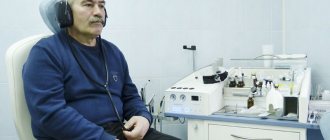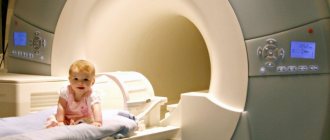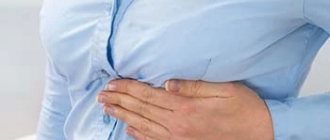Some patients who experience frequent migraines or tension headaches may attribute their illness to weather dependence, increased stress at work, or general fatigue that has accumulated over long days without rest. In fact, the problem may lie much deeper.
Typically, patients with chronic headaches note that the pain begins on one side of the neck or the base of the skull and spreads through the parietal and temporal regions to the forehead and eyeball.
This is the so-called “helmet removal” type of pain: if the patient is asked to show with his palm where the pain begins and how it spreads, then he performs a movement reminiscent of removing a helmet from his head. This type of pain is called a cervicogenic headache (that is, “coming from the neck”).
The source of this pain syndrome can often be the greater occipital nerve or Arnold's nerve. This nerve is formed from the second cervical nerve root and passes under the base of the skull. On its way from the spinal canal, it goes around the C1-2 intervertebral joint (the joint between the 1st and 2nd cervical vertebrae). The vertebral artery passes close to the nerve. The nerve passes through the muscles of the cervico-occipital region and follows to the scalp (No. 5 - greater occipital nerve).
Location of the greater occipital nerve
If the greater occipital nerve is damaged, a pain syndrome of the type neuralgia may develop: occipital neuralgia (or Arnold's neuralgia).
The main causes of damage to nerve fibers that can lead to inflammation:
- Pathologies of the cervical spine, for example, damage to the intervertebral joints, osteochondrosis, herniated intervertebral discs, bone tumors.
- Neck injuries, traumatic brain injuries.
- Prolonged tension in the neck muscles.
- Diabetes mellitus is a disease in which disturbances occur in small vessels, as a result, nerve fibers cease to receive sufficient amounts of oxygen and nutrients.
- Some infectious diseases.
- Inflammatory processes in blood vessels.
People who have a constantly tense neck due to prolonged stay in a monotonous position (working at a computer) and frequent similar movements are more prone to damage associated with pathological changes in the cervical vertebrae and muscles.
At the Medical Center International Clinic Medica24, a diagnosis of occipital nerve neuritis will be quickly and professionally carried out, and our neurologists will prescribe effective treatment for you.
We will call you back
Message sent!
expect a call, we will contact you shortly
All about occipital neuralgia: symptoms, diagnosis, treatment methods
Occipital neuralgia is a disease accompanied by severe headaches in the back of the head. There are 2 types of this disease. If neuralgia develops on its own, then it is primary. If the disease appears as a result of injury, then this is secondary neuralgia.
What are the causes of the development of occipital neuralgia?
As a rule, the described disease progresses against the background of other diseases. Among them it is necessary to highlight:
- Diseases of the cervical spine;
- Acute respiratory viral infections, influenza, sore throat;
- Aneurysm of the vertebral artery;
- Gout;
- Lymphadenitis of the cervical glands;
- Cancer of the brain or spinal cord.
In addition, spinal injuries lead to the development of occipital neuralgia.
Main symptoms
Pinched fibers of the occipital nerve are susceptible to inflammation. For this reason, severe headache occurs in the back of the head. Sometimes it can radiate to the neck, temples, and lower jaw. The patient's condition worsens with sudden turns of the head: nausea appears, and the eyes may hurt.
Inflamed nerves become very sensitive. Lightly pressing on the affected area will make the migraine worse. Because of this, people suffering from occipital neuralgia often tilt their heads rather than holding them straight.
Another symptom of the described disease is a change in skin color in the back of the head. At the same time, the skin looks either slightly red or too pale.
The eyes also react to the development of occipital neuralgia. In this regard, many patients complain of involuntary lacrimation.
If you experience one or more of the symptoms listed above, then be sure to consult a doctor. The doctor will make the correct diagnosis and prescribe treatment. In this way, you will protect yourself from disruption of the innervation of the area of the affected nerve.
Briefly about diagnostics
The diagnosis is made by the doctor after a conversation with the patient. In addition, the specialist uses the information obtained as a result of the patient undergoing a palpation examination. It is also possible to use other techniques, for example, MRI, fluoroscopy.
Treatment information
The main goal of treatment is to relieve the patient of muscle spasms and migraines. If occipital neuralgia develops intensively, then the patient should be at rest as much as possible. Moderate pain can be relieved by taking medications and B vitamins in tablets. You should also take muscle relaxants and anti-inflammatory drugs.
If headache attacks are incredibly severe, and pills do not help, then corticosteroids and anesthetics should be injected subcutaneously to alleviate the condition. In this case, the effect will not take long to appear, but it will be short-lived.
If the disease has progressed to a subacute period, then warming procedures will bring tangible benefits. For example, you can apply compresses to the affected area. In addition, often the course of treatment for occipital neuralgia includes manual therapy, acupuncture, and massage.
There are 2 procedures that help overcome the described illness. The first of these is radiofrequency ablation. This technique is based on heating the inflamed nerve. The second procedure is electrical stimulation. This is a type of physical therapy. It is notable for the fact that it has no contraindications. In this case, the affected area is exposed to electrical impulses that relieve pain.
What can the lack of treatment lead to?
If the occipital nerve is pinched and inflamed, but for some reason the patient decides not to visit the clinic, then he is at great risk.
Left untreated, it can lead to serious health problems. In particular, the development of occipital neuralgia can cause loss of vision and curvature of the neck. Author: K.M.N., Academician of the Russian Academy of Medical Sciences M.A. Bobyr
Treatment of neuritis of the occipital nerve
Typically, treatment of the disease begins with the following measures:
- Anti-inflammatory and painkillers.
- Muscle relaxants are medications that help relax the neck muscles.
- Massage.
- Physiotherapeutic procedures.
- Warmth on the neck and back of the head.
- Creating rest for the neck muscles.
In each case, the doctor selects treatment individually. If the pain, despite the therapy, does not go away, blockades are used: anesthetics and steroidal anti-inflammatory drugs are injected into the area of the affected nerve.
In the most severe cases of neuritis, the doctor may recommend one of the following types of surgical treatment:
- Rhizotomy is an intervention during which the affected nerve root is destroyed, thereby blocking pain.
- Neurolysis is damage to nerve fibers using high, low temperatures or special chemicals, thereby blocking the transmission of pain impulses.
- Decompression is the elimination of compression of nerve fibers by surrounding tissues.
This disease does not pose a threat in terms of severe complications, even if it is not treated at all. However, it is accompanied by pain, which reduces the quality of life and prevents you from fully engaging in work and everyday activities.
Proper treatment can effectively manage painful symptoms. Make an appointment with a neurologist. At the medical center International Clinic Medica24 this can be done any day, at any time of the day by phone.
The material was prepared by Natalya Yurievna, a neurologist at the international clinic Medica24, Candidate of Medical Sciences Lasch.
Symptoms of cervical neuralgia
The main symptom of the pathology is headache. With occipital neuralgia, it has a specific character:
- pain is concentrated behind the ears, in the back of the head, lower neck, in the eye area;
- painful attacks occur suddenly, usually after turning the head or touching the area of innervation of the occipital nerve;
- pain is more often localized on one side, bilateral damage is less common;
- the pain has a shooting character, appears sharply and suddenly disappears;
- bright light causes pain in the eyes.
In addition to pain, symptoms of neuralgia of the head include:
- impaired sensitivity in the back of the head;
- forced head position;
- pale skin;
- feeling of "goosebumps";
- feeling cold;
- increased pain when coughing, sneezing, turning the head.
Diagnosis of inflammation of the occipital nerve
The clinical manifestations of the disease are similar to migraine and a number of other neurological pathologies. Help to identify the disease:
- radiography;
- CT scan;
- Magnetic resonance imaging.
Trigeminal neuralgia: symptoms and treatment
After the first painful attack, you can grimace as much as you like, feel every millimeter of facial skin and even pat yourself on the cheeks approvingly. Everything is fine! But the fear of the next attack has already settled in my soul forever... This is how most of my patients describe the debut of a painful and difficult-to-treat disease called “trigeminal neuralgia” (trigeminal neuralgia, Fothergill’s disease).
Waiting for the pain
Unlike tension headaches, trigeminal neuralgia is characterized by sudden, short-term, intense, recurring pain in the area of innervation of one or more branches of the trigeminal nerve, usually on one side of the face, but can affect both sides, and can (in an atypical form) manifest as a burning sensation , pressing, aching, bursting, constant or wave-like pain or a feeling of goosebumps running across the face.
Attacks of these pains in the face (lip, eye, nose, upper and lower jaw, teeth, gums, tongue) can occur spontaneously or be provoked by talking, chewing, brushing teeth, touching certain areas of the face (trigger points that trigger an attack; usually located in area of the nasolabial triangle). Their frequency varies from single to tens and hundreds per day! During the period of exacerbation, more often in the cold season, attacks become more frequent.
The pain is so severe that patients cannot concentrate on anything else and are in constant tension, all the time waiting for the next attack (they do not touch the painful side of the face, do not brush their teeth, do not chew on the affected side). There have been cases where patients, unable to bear the pain any longer, committed suicide.
What really hurts
The main cause of true trigeminal neuralgia is compression (squeezing) of the trigeminal nerve root by an arterial and, less commonly, venous vessel directly at the brain stem, from where this nerve actually exits.
The trigeminal nerve, on the one hand, is the main sensory nerve of the face and oral cavity, on the other, it also contains motor fibers that innervate the masticatory muscles. Therefore, in addition to transmitting information to the brain about what our face is doing at any given time, the trigeminal nerve carries impulses to some of its own facial muscles, which is why pain is often accompanied by a tonic, long-term (trismus), or short-term (tic) contraction of these muscles.
There are several hypotheses to explain why nerve compression leads to the development of trigeminal pain, but none of them is yet generally accepted. In all cases, confirmation of a neurovascular conflict is carried out only with the help of MRI, so the doctor will definitely refer you to this study. Unfortunately, in 15% of patients, even an MRI is not able to accurately establish a diagnosis. Then electromyography (EMG) or electroneurography (ENG) can help doctors.
Diagnostic problems
But alas, most often after the first attacks a person is sent not to a neurologist’s office, but to a dental clinic. This is due to the fact that the area of pain is located not only on the face, but also in the oral cavity. Very often, healthy teeth are removed by mistake on the affected side, sometimes this “attraction” lasts for months and years, and only after losing half of the “emergency reserve” of teeth does the patient begin to suspect something...
The standard for diagnosing classical trigeminal neuralgia, according to the diagnostic criteria of the International Headache Society (IHS, ICHD-II), is the presence of at least 4 points out of the 5 below:
- The pain occurs in the form of attacks lasting from several seconds to 2 minutes in areas of the face corresponding to the zones of innervation of the trigeminal nerve.
- The pain is sudden, intense, sharp, similar to an “electric discharge”, caused by irritation of various areas of the face and oral cavity when eating, talking, washing the face, brushing teeth.
- Attacks of pain are stereotypical for each patient.
- There are no neurological symptoms during the interictal period.
- Taking carbamazepine causes pain relief at the onset of the disease.
Conservative therapy
Treatment always begins with conservative therapy, the basis of which is anticonvulsants (in particular carbamazepine). Their use at the onset of true trigeminal neuralgia leads to regression of the pain syndrome in 90% of patients. That’s why it’s so important not to delay seeing a doctor! However, with long-term use, the effectiveness of the drugs sooner or later decreases, toxic damage to the liver, kidneys, and changes in the cellular composition of the blood may develop, so conservative therapy can only be considered temporary.
In turn, patients prefer vascular drugs, antispasmodics, sedatives, ointments with anesthetics, physiotherapeutic procedures, acupuncture, laser therapy, and are happy to use traditional medicine methods and efferent methods of therapy (plasmapheresis, hemosorption).
In my experience, all this does not bring any particular relief, but it significantly distracts from the anxious anticipation of an attack. And... the time before examination and surgical treatment is delayed, which sometimes leads to tragic consequences. Meanwhile, the operation cannot be delayed.
Neurosurgical treatment
As for surgical treatment, today neurosurgeons have two main methods at their disposal:
Vascular decompression.
The essence of the method, as the name suggests, is to eliminate compression, i.e. compression of the nerve by the adjacent vessel. The method is indicated for all types of vascular compression of cranial nerves. To use it, an established diagnosis of classical trigeminal neuralgia is sufficient. A contraindication is the presence of severe concomitant pathology that makes it impossible to perform a neurosurgical operation.
Stereotactic radiosurgery, or “gamma knife”.
To achieve the effect, the trigeminal nerve root is irradiated with a dose of ~ 90 Gy and the affected cells are “burned out”. Indications for the use of this method are aggravated somatic status (presence of chronic diseases, mainly cardiovascular and endocrine) and the patient’s categorical refusal of surgical intervention. The use of the method is justified by the non-invasiveness of the technique, which significantly reduces the likelihood of complications, however, radiosurgery is less effective and has a higher number of relapses.
In general, the success of treatment for trigeminal neuralgia, just like the treatment of other diseases, depends on a clear diagnosis, strict adherence to surgical technologies and... your timely visit to the doctor!
Valentina Saratovskaya
Photo thinkstockphotos.com
Products by topic: [product](carbamazepine)
Diagnosis of inflammation of the trigeminal nerve
Depending on the affected area and the set of symptoms, the strategy for diagnosing the disease is determined. To determine the location of nerve damage, the severity and dynamics of recovery, doctors prescribe a hardware diagnostic method, for example, electromyography. MRI and CT scans are used to determine the presence of tumors in the brain.
The patient may also be referred for a general or biochemical blood test, x-ray of the lungs, ultrasound of soft tissues or ophthalmoscopy.
You can be confident in the quality of the procedures performed in the clinic and the high accuracy of the results of MRI, CT and other methods of diagnosing various diseases. Medunion performs magnetic resonance imaging of all types: head, spine, abdominal cavity and joints using modern equipment.
Features of the treatment of cervical neuralgia
Drug therapy is based on the use of drugs that relieve the patient of unpleasant symptoms. For this purpose, patients are prescribed painkillers. To eliminate muscle spasms, muscle relaxants are prescribed.
Patients are also prescribed anticonvulsants, steroidal anti-inflammatory drugs, sedatives, and B vitamins. In cases of extremely severe pain due to inflammation of the occipital nerve, novocaine blockades can be used.
Physiotherapy helps to achieve good results:
- physiotherapy;
- acupuncture;
- special massage;
- spinal traction;
- ultrasound therapy;
- magnetic therapy;
- electrophoresis;
- laser therapy.
When treating scalp neuralgia, physiotherapy is combined with medications. This allows you to quickly get rid of pain and neurological manifestations.
In addition to relieving symptoms, it is important to pay attention to the root cause of neuralgia and eliminate it.
If the pain persists for a long time, is severe, and conservative treatment of occipital neuralgia does not bring results, radical measures may be resorted to. For this purpose, use:
- stimulation of the occipital nerves in the projection of the nerve exit (electric current is used);
- pulsed radiofrequency ablation of the occipital nerves;
- microvascular decompression (microsurgical technique to eliminate nerve compression).
Treatment for inflammation of the facial nerve
Drug treatment
Treatment of trigeminal neuritis is complex. The disease is first treated with medication - the patient is prescribed drugs that will alleviate the situation. These include painkillers, decongestants, vasodilators and B vitamins. Most often, the recommended medications are tablets, but you can speed up the recovery process by using ointments and gels. Sometimes doctors prescribe intramuscular injections.
In special cases, the recovery process of the facial nerve may be slowed down. Then the patient is prescribed glucocorticosteroids, which improve the metabolic processes of nervous tissue. Various biostimulants and hyaluronidases also contribute to a speedy recovery.
You cannot prescribe medications for yourself. Be sure to see a neurologist or neuropathologist at the first symptoms to determine the diagnosis and treatment strategy. Recovery medications are recommended to patients on a case-by-case basis, paying attention to the presence of chronic diseases, symptoms, and so on.
Surgery
Another way to treat the facial nerve is surgery. However, doctors turn to this option quite rarely - only when the trigeminal nerve is ruptured. Surgery is also required if there is no effect from the conservative method after six months or a year. Surgical intervention is only relevant during the first year of the presence of the disease; later, the muscles on the face irreversibly atrophy.
The surgical process involves suturing the damaged area of the facial nerve to restore its motor function.
Massage
The next treatment method is massage for the treatment of the facial nerve. The purpose of this method is to remove swelling, improve blood circulation, restore sensitivity and conduction of nerve impulses. Massage is contraindicated for tuberculosis, oncology, atherosclerosis and elevated temperature.
Initially, the massage therapist works only with the healthy side of the face, collar area, neck and area above the shoulders. Basically, the master uses rubbing, stroking, kneading and vibration.
For noticeable desired changes, it is necessary to conduct ten to twenty massage sessions from five to fifteen minutes. The duration is determined based on the degree of inflammation of the trigeminal nerve, the goals of therapy and the dynamics of recovery.
Physiotherapy
The next treatment method is physical therapy. It alleviates the severity of symptoms, helps to activate metabolic processes in tissues and restore the functions of the facial nerve.
Doctors prescribe this course of treatment from the first days of the onset of neuritis. The list of physical procedures includes:
- Ultrasound
- Laser irradiation of blood
- Electrophoresis of drugs
- Microwave therapy
- Exposure to ultra-high frequency electricity
- Ozocerite treatment
- Myoelectrostimulation
- Darsonvalization
This complex is indicated for the first week of treatment. Doctors prescribe it together with medication. This tandem helps speed up the process of restoration of the facial nerve. And its most important advantages are the absence of side effects and painlessness.
Alternative Methods
There are also alternative treatment methods. These are procedures aimed at restoring facial muscles and eliminating the symptoms of facial neuritis. Such procedures include:
- Clay or paraffin masks
- Acupuncture
- Reflexology
- Injections to eliminate muscle disorders
- Therapeutic baths
- Taping – stretching the face using adhesive plasters
- Immunosorption – purification of blood from antigens and antibodies
- Biofeedback – facial muscle training
Gymnastics for the face
Also, in conjunction with complex treatment, you can do facial exercises. Before this, you need to consult with a specialist; the doctor will draw up an individual list of exercises based on the severity of the process, location of the lesion and symptoms. Typically, such gymnastics takes about ten minutes a day.
A standard set of exercises includes relaxing and tensing individual facial muscles. For example, to restore articulation, it is recommended to pronounce the sounds “u”, “o”, “and”. Afterwards, you need to bring your lower lip under your upper teeth and reproduce the sounds “v” and “a”.
Gymnastics for inflammation of the trigeminal nerve:
- Close eyes
- Raise your eyebrows
- Frown
- Squint
- Smile with your mouth closed
- Smile with your mouth open
- Puff up your cheeks
- Pull them back
- Whistle
- Widen your nostrils
- Curl your lips
- Raise your upper lip and return to the starting position
- Lower your lower lip and return to the starting position
- Take water into your mouth
- Rinse your mouth
- Close your mouth
- Run the tip of your tongue along your gums
- Move your tongue right and left









